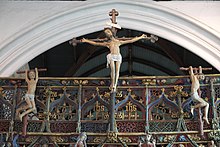Rood screen (Le Faouët)
The wood-carved and colored rood screen is one of the most important pieces of equipment in the Saint-Fiacre chapel in Le Faouët , a community in the Morbihan department in the French region of Brittany, along with the stained glass windows from the Renaissance . The late-Gothic rood screen, which is one of the oldest surviving wooden letters in Brittany, was created by Olivier le Loergan (or Loernagan) between 1480 and 1492. As early as 1862, the rood screen was included in the list of architectural monuments in France as a monument historique .
description
The rood screen , carved from oak, consists of a choir screen , a gallery and, facing the nave , a crucifixion group .
Choir screen
The choir screen is divided into seven pointed arcades decorated with filigree tracery in the flamboyant style . In the middle, wider arcade, a door with two wings opens. The keel arches of the arcades are covered with crabs and finials , the supports have slender columns and small figures standing under canopies. The choir screen is closed at the top by a beam, which is decorated on the choir side with a frieze of foliage and two grotesque figures that seem to be almost crushed by the weight of the gallery above. On the side facing the nave, scenes from the life of St. Martin as well as Gregory's mass and episodes from the Roman de Renart are carved.
Gallery
A gallery is built above the choir screen, protruding into the choir in the east and the nave in the west . It rests on both sides on five yokes of wooden ribbed vaults with carved keystones . The arcade arches end in pendants , which are decorated with acrobats and animals on the side facing the choir, and angel figures on the side facing the nave. The lace-like openwork gallery grids show ermine tails , fleur-de-lys and the Christ monogram IHS .
Small figures can be seen in the spandrels of the arcade arches, depicting the Annunciation scene and the expulsion of Adam and Eve from Paradise on the side facing the nave. Adam and Eve stand under a fig tree and cover themselves with a fig leaf, next to them one sees an angel with a sword in hand under an apple tree, around which a snake winds and from whose branches, which are draped with red fruits, the face of the devil emerges.
The scenes on the side facing the choir are supposed to represent vices. A man who picks apples probably stands for the theft, a man with a barrel and empty canteen, from whose mouth a fox slips, is a symbol of gluttony and drunkenness, a man and a woman embody lust, a bagpiper should do it Denouncing idleness.
Crucifixion group
The crucifixion group consists of five figures. The two thieves are shown next to Christ on the cross , under the cross are Mary and the apostle John. The trunks and beams of the cross are provided with stumps .
literature
- Le Patrimoine des Communes du Morbihan . Flohic Éditions, Volume 1, Paris 1996, ISBN 2-84234-009-4 , pp. 242-243.
- Brittany . Hachette, Guides Bleus, Paris 1991, ISBN 2-01-015841-5 , p. 336.
Web links
- Lettner The large art lexicon by PW Hartmann
- Le jubé de la chapelle Saint-Fiacre du Faouët (accessed May 21, 2019)
Individual evidence
- ↑ Jubé in the Base Palissy of the French Ministry of Culture (French)
- ↑ Jubé in the Base Palissy of the French Ministry of Culture (French)
- ^ Clôture liturgique in the Base Palissy of the French Ministry of Culture (French)
- ↑ Tribune in Base Palissy of the French Ministry of Culture (French)
- ↑ Calvaire in the Base Palissy of the French Ministry of Culture (French)
Coordinates: 48 ° 0 ′ 50.8 " N , 3 ° 29 ′ 12.6" W.

















